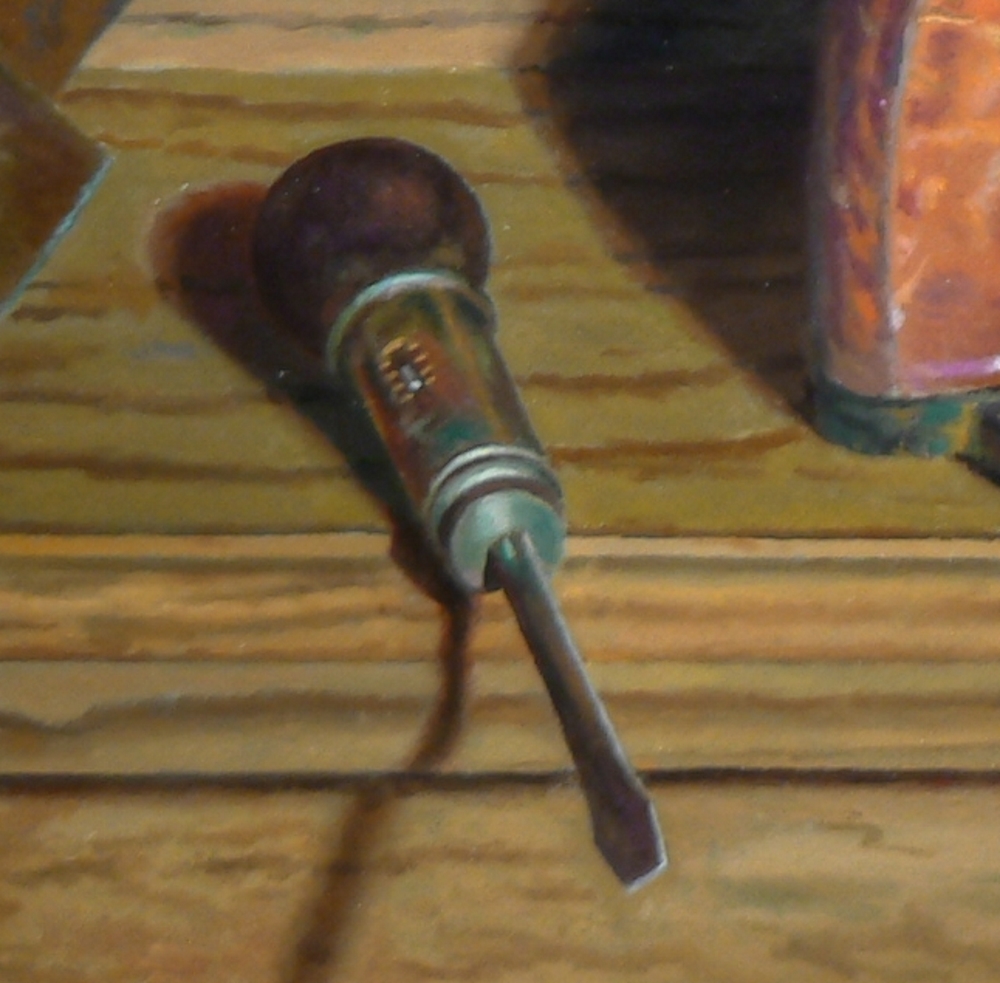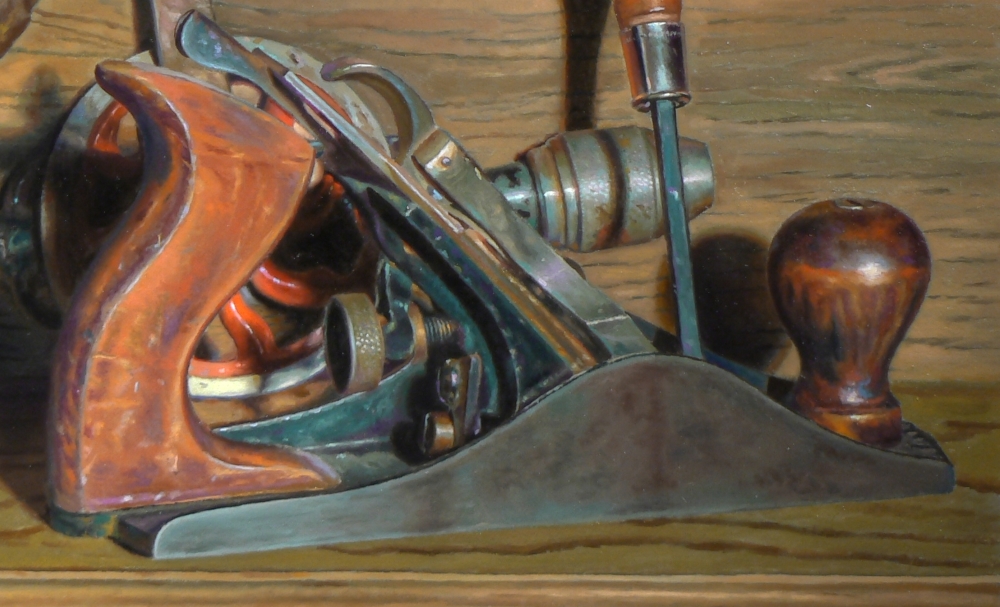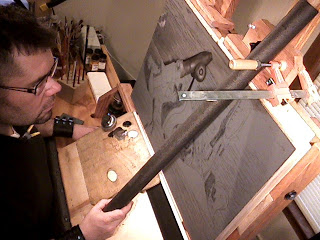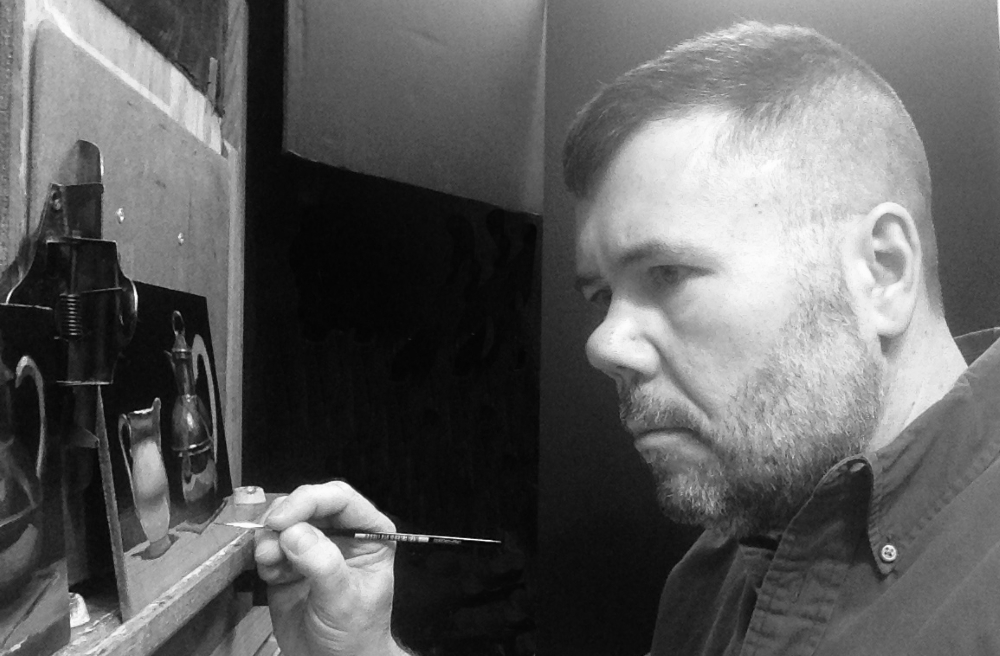"Metal and Wood" An Original Still Life Painting
When I was twelve, my father and I undertook a project that would leave a lasting imprint on both my life and my art. We built a desk together—though it was more than just furniture. It was a chance to learn about craftsmanship, discipline, and the delicate balance between control and creativity.

My father, a talented woodworker and a gifted teacher, taught me one critical lesson as we distressed the surface of the wood to give it an aged look: “Don’t overdo it.” Simple though it seems at first, that wisdom has stayed with me, shaping my artistic process to this day.
It feels a part of a legacy passed down to me from many generations in my family involved in this kind of work.
The Story Behind The Painting
The desk we built wasn’t just a functional piece; it grew out of my father’s meticulous sense of craftsmanship and attention to detail. After the basic carpentry was finished, we set about distressed the wood to give it an antique look. This was done in what seemed like a rough manner: by whipping it with chains, gouging it with screwdrivers, and piercing it with awls.

Yet, the most important part was knowing when to stop. My father’s gentle reminders—“Don’t overdo it”—taught me that restraint is as vital as the work itself. This lesson resonated deeply, especially in an age filled with indulgence and excess.
Much like life, art requires a balance between vitality and constraint. Too much exuberance results in chaos, but too much discipline can suffocate creativity. Striking that balance in my work is like digging for treasure—mining the depths of inspiration with careful focus, until the true value of the piece emerges.

This approach has shaped many of my works, including Metal and Wood, which embodies the values passed down through generations of craftsmen in my family. The tools depicted, though not direct heirlooms, reflect the deep connection between artist and tools—whether a hammer or a palette knife. Each stroke recalls the precision and care inherited from those before me.
In my process, every stage, from the first sketches to the final layers of color, is deliberate. Like the lessons of my childhood, it’s about knowing when to add and when to hold back
The Creation Of “Metal And Wood”
Creating “Metal and Wood” was a deeply intentional and meticulous process, one that spanned over a month and reflected my approach to every painting in my studio. This work, like many of my pieces, began with a clear vision for both the subject matter and the lighting.

The Setup
The objects in the painting were arranged carefully inside a shadow box, which allowed me to manipulate light and shadow to convey the precise mood I wanted. I was fascinated by the architectural possibilities inherent in these wonderful tools, so I built up a dense arrangement to suggest building and construction.
The Studies
Before putting brush to panel, I spent time doing preliminary studies—small, detailed sketches and color explorations. These studies help me plan out the composition and balance before committing to the full-sized painting. The importance of these preparatory steps can’t be overstated; they provide a chance to refine ideas and resolve any issues before the final execution.
The Drawing
Once the studies were completed, I moved on to the drawing phase. Using pencil, I sketched out the composition in detail on the prepared wood panel. This drawing established the foundational structure for the entire painting, outlining the forms and also suggestion some of the interplay between light and shadow.

The Underpainting
Next came the underpainting—a monochromatic layer using only black and white. This step solidified the design and allowed me to focus purely on the light and dark values without the distraction of color. The underpainting serves as the backbone of the piece, ensuring the lighting and contrast are accurate before adding the complexities of color.
The Color Layer
Once the underpainting was dry, the color layer could begin. This stage is where the painting comes to life. I applied colors both opaquely and through glazing techniques, building up depth and richness in the tones. Glazing—where thin, transparent layers of paint are applied—creates a beautiful, luminous effect that allows the light to pass through and interact with previous layers of color.

Final Touches
Once the final layer was complete, the painting required several weeks to dry. Only then could I apply a varnish to bring out the depth and protect the surface. The painting was then ready to be framed and presented.
By the time “Metal and Wood” was finished, it had become more than just a still life—it was a reflection on craftsmanship, family tradition, and the lessons of restraint and discipline that guide my artistic process.
The Meaning And Philosophy Behind “Metal And Wood”
At its heart, “Metal and Wood” reflects my deep connection to craftsmanship and the generations of artisans in my family. The tools depicted aren’t just objects; they embody the legacy of skilled hands, from my great-grandfather, a tool maker, to my grandfather, a carpenter, to my father, a master woodworker. In this painting, these tools symbolize those traditions and disciplines.

When I paint still life, my goal is not only to replicate objects but to tell a story through them. The arrangement of the tools and the careful play of light speak to the balance between vitality and restraint—a concept that applies to both life and art. Like my father’s lesson in woodworking, “Don’t overdo it,” this painting required that same balance. Too much energy leads to chaos, while too much discipline stifles creativity. This piece, like all good still life, embraces that middle path, where both vitality and control coexist.
I see art as a process of excavation, much like mining for treasure. In “Metal and Wood,” I dug deep into my past and my artistic discipline to create something meaningful—an homage to tradition and the slow, deliberate search for balance in life and craft. This painting is not just about tools; it’s a story about the history and people they represent.
The Painting

oil on panel, 17×24 inches (sold)
“Metal and Wood” has sold, and is now part of a private collection in California.
However, fine Giclée reproductions are available in a range of sizes. These prints are made with lightfast inks applied to archival canvas wrapped on a wooden stretcher frame. The edges are painted black, and they are ready to hang without further framing (select framing options are available).
To explore, click the blue button below.
About The Artist

My formal education was in music (violin and composition), yet after school I found my way into a practical career as a computer programmer.
Painting was always an intense curiosity for me, though.
So, for my 30th birthday, I purchased a small oil painting kit. This weekend hobby took on a life of its own, and after several years I left my comfortable life in technology to pursue this more uncertain – and much more satisfying – path.
I have painted still life exclusively for the last dozen years. I find it to be the perfect synthesis of tradition and exploration, and for me it is the ideal vehicle to search for both the inner and outer light.
I am deeply honored that over 700 collectors have chosen to bring my paintings into their homes, with many of them collecting multiple works.